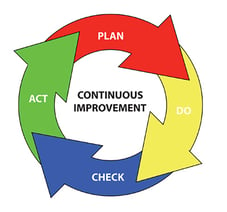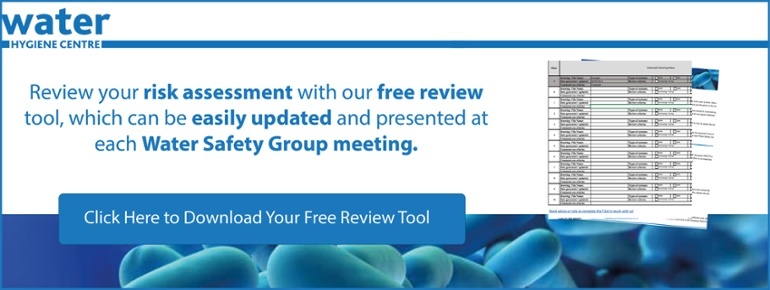In this blog, we consider records for water safety. When we say ‘records’ we don’t mean the round vinyl LP type (Handel’s ‘Water Music’, anyone?). No. We are focusing on records that form documented evidence to demonstrate water safety compliance.
Why do you need Water Safety Records?
Let’s start by taking a step back and understanding where the need for records stems from. The Management of Health and Safety at Work Regulations 1999 require employers to carry out risk assessments, make arrangements to implement necessary measures, appoint competent people, and arrange for appropriate information and training.
With each one of these fundamental requirements, there will be some form of associated written record to deliver, define, shape, and/or explain. This is further explained in the HSE guide HSG65 Managing for Health and Safety with the Plan / Do / Check / Act principle:
Plan / Do / Check / Act
Moving on to the more specific requirement to manage water safety within an organisation, the same principles of Plan / Do / Check / Act will apply to Duty Holders to ensure they comply with their legal obligations:
- Legionella Risk Assessment – documented assessment [where greater than five employees] identifying and assessing the source of risk;
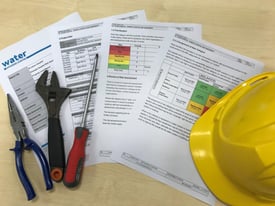 Water Safety Plan – preparation of a WSP for preventing and managing the risks identified in the assessments;
Water Safety Plan – preparation of a WSP for preventing and managing the risks identified in the assessments;- Implementation – delivery of monitoring precautions and management plans to ensure water systems are under control;
- KEEP RECORDS – evidence of precautions and actions;
- Appointments – written appointment of a person/s with sufficient authority and knowledge of water safety.
What Water Safety Records do I need?
For each of these, you’ll see that some form of record is required, some of these may be more detailed and onerous than others and the format of the document may vary.
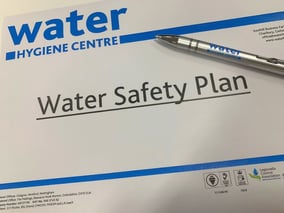 Concerning appointments, this will start with the appointment of a Responsible Person (Water). The RP(W) has an overarching responsibility to ensure that the written scheme or ‘Water Safety Plan’ is well managed and remains effective, relative to the identified risks. Moreover, risk can change with an evolving estate, so it’s imperative that an RP’s approach to managing risk is equally dynamic and that this can be evidenced by suitable record-keeping. The suitability of records and the effectiveness of the Water Safety Plan can be determined by a process of regular reviews.
Concerning appointments, this will start with the appointment of a Responsible Person (Water). The RP(W) has an overarching responsibility to ensure that the written scheme or ‘Water Safety Plan’ is well managed and remains effective, relative to the identified risks. Moreover, risk can change with an evolving estate, so it’s imperative that an RP’s approach to managing risk is equally dynamic and that this can be evidenced by suitable record-keeping. The suitability of records and the effectiveness of the Water Safety Plan can be determined by a process of regular reviews.
The review process should include regular Water Safety Group meetings involving key staff members who are instrumental in the provision of safe water systems. The membership will vary depending on the size and complexity of the organisation, typically members include a Deputy Responsible Person, Authorised Person, Authorising Engineer (Water), Microbiologist, Infection Control and Facilities Representatives. All these persons will be responsible for an individual or shared element of the Water Safety Plan and in doing so have a collective responsibility for water safety.
The Water Safety Group will follow a defined and relevant agenda i.e., policy (including appointments, competency, and training), risk assessments, operational management and logbooks. For example:
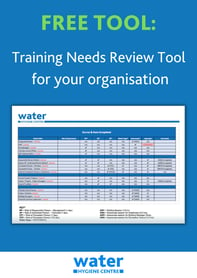 Legionella Training & Competency: Review a defined training analysis matrix for all individuals involved in water management, including those external organisations you may have appointed. This should involve the review of applied skills and knowledge, through a defined appraisal process, as evidence of competency;
Legionella Training & Competency: Review a defined training analysis matrix for all individuals involved in water management, including those external organisations you may have appointed. This should involve the review of applied skills and knowledge, through a defined appraisal process, as evidence of competency;- Water Safety Audits: reviewing the findings of periodic audits including the Authorising Engineer (Water) audits;
- Operational Records: may consist of information provided by internal competent persons but also external service providers, where is the evidence-defined processes and competency of their staff?
Water Safety Group meetings will focus on evidence of compliance, through defined reporting processes that inform the RP(W) as to whether the risk of water safety is adequately managed (or not).
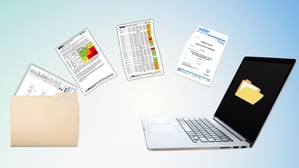 The ‘type/format’’ of records may vary between organisations based on the record management system you have in place i.e. paper records / electronic records. Paper records should be held within a defined file structure and this should be replicated on a ‘shared’ computer drive if paper records are scanned. With electronic records and data capture systems, there is a reliance on pre-set parameters and establishing all the required monitoring points. Once such a system is in place, it is important that all relevant staff can use the system competently and retrieve meaningful data reports.
The ‘type/format’’ of records may vary between organisations based on the record management system you have in place i.e. paper records / electronic records. Paper records should be held within a defined file structure and this should be replicated on a ‘shared’ computer drive if paper records are scanned. With electronic records and data capture systems, there is a reliance on pre-set parameters and establishing all the required monitoring points. Once such a system is in place, it is important that all relevant staff can use the system competently and retrieve meaningful data reports.
Records should be retained for the period in which they remain current and:
- For an additional two years for risk assessments;
- For an additional five years for all monitoring and inspection data.
In summary, records are evidence of compliance. Without adequate records, it is very difficult to convince others, including outside agencies, that a task has been completed. Records are a fundamental foundation stone of successful water safety management which also allow you to defend or prosecute a site if it becomes legal and hence are of critical importance.
Organisations should routinely take the opportunity to review each step of the water safety process and ensure there is adequate detail, information, instruction, reporting and mitigation in place. Records are your evidence, not your vinyl collection!
Further reading is available> Legionella record keeping using software
Feel free to reach out if you have any questions about the issues mentioned above or if you would like to consult with one of our experts on water hygiene.
Editors Note: The information provided in this blog is correct at the date of original publication - November 2018. (Revised December 2023)
Image by Siggy Nowak from Pixabay
© Water Hygiene Centre 2023




